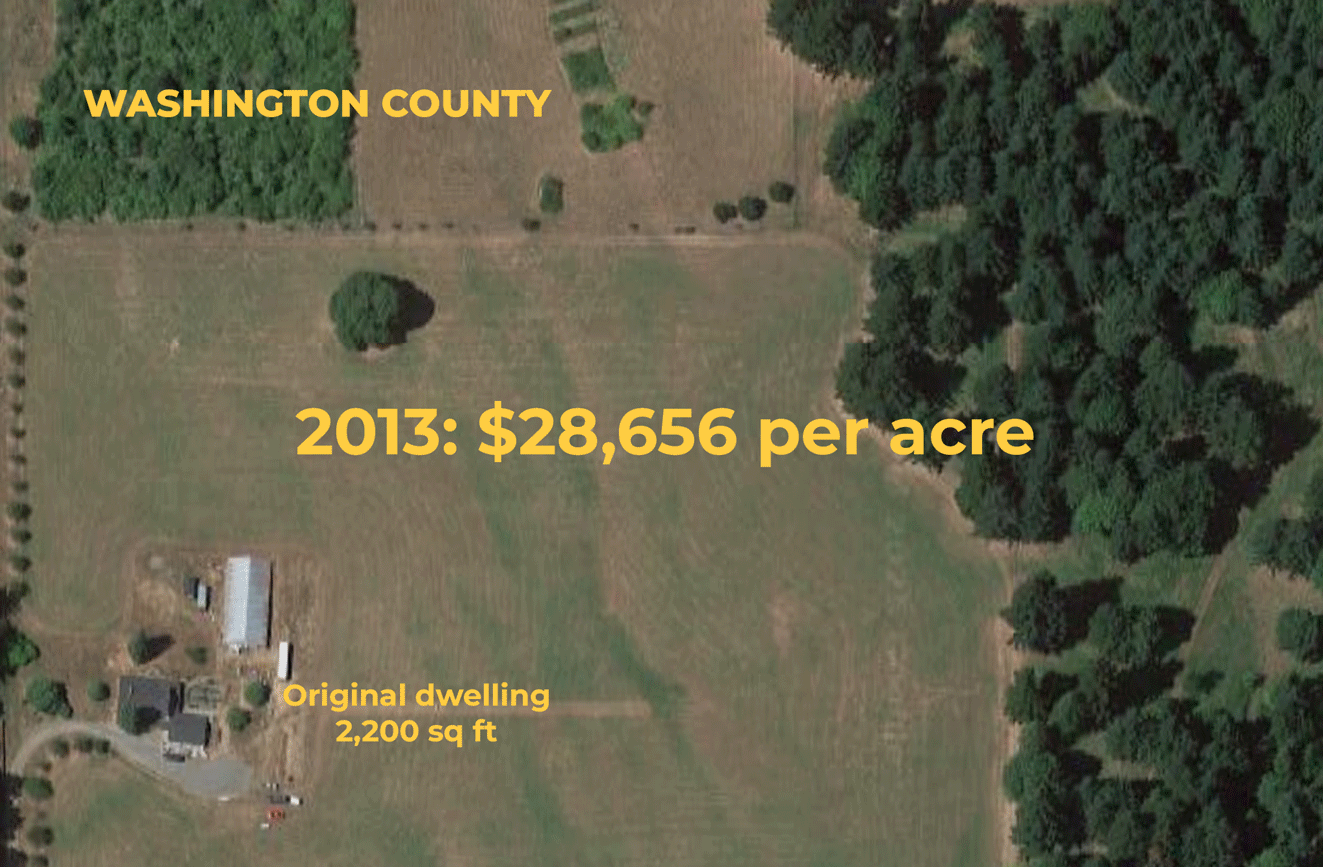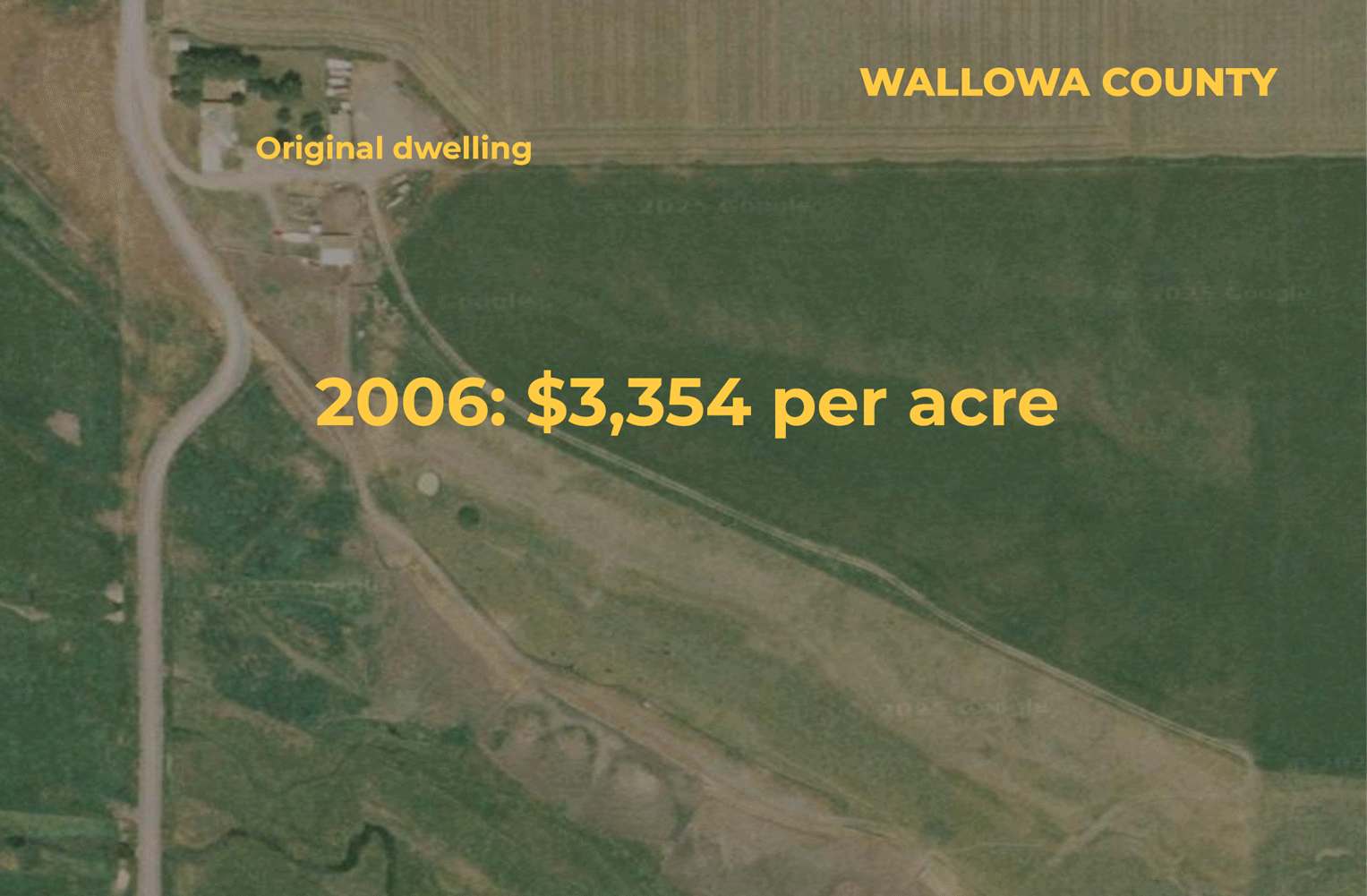Across rural Oregon – where farms and ranches predominate – a creeping supply of newly built luxury homes has grown on agricultural and forest lands in the last few decades, further eroding the state’s decreasing allocation of resource land and raising agricultural and forest land prices. These homes are built using a loophole in Oregon’s land use system: replacement dwelling permits, which are specifically designed to help people recover after a natural disaster or other hardship. A bill introduced for 1000 Friends of Oregon in the 2025 legislative session would help address the issue.
“Land speculation for luxury homes is driving up the price of agricultural land beyond what farmers and ranchers can afford and creating expensive conflicts for agricultural producers,” says Mickey Killingsworth, the secretary-treasurer of the Jefferson County Farm Bureau. In a single year, from 2023 to 2024, the average value of Oregon’s farm real estate increased 6.3 percent, outpacing the national average.
“New and beginning operators are being priced out of the agricultural and forest land markets by the inappropriate development of luxury homes, recreational outfits, and commercial hospitality and entertainment businesses,” says Jacque Duyck Magwood, a Washington County berry farmer.
The effects can tear into the fabric of farming and ranching communities and alter the next generation’s ability to continue farming the land. Even when a replacement dwelling is just a significantly more expensive and larger home, the changes still drive the cost of land sharply upward and, in many cases, still functionally convert the use of the property away from agriculture or forest management.
The approval of multimillion dollar homes with no connection to agriculture or consideration of impacts on surrounding farms and ranches is effectively forcing land out of the food-production rotation – not just right now but for future generations too. “The use of replacement dwellings to build large trophy estates or short-term rentals is affecting the existing stock of housing for farmers and farmworkers to use,” says Jim Johnson, working lands policy director. “It’s not just about increasing land costs – it’s also an affordable housing issue. It’s taking away houses that were used for farmers and farmworkers.” Attempting to sell such a home can be a yearslong waiting game, and an eventual new buyer likely won’t farm the land either – because who’s buying a $13 million estate to grow hay?

A replacement dwelling in an mixed farm/forest use zone in Washington County.
Rule designed for hardship, misused
Landowners can have good reasons to replace old farm structures, such as rebuilding after a fire, and farmers and ranchers deserve reasonable pathways to replacing their homes when needed.
“The policy behind replacement dwellings is to address the hardship homeowners face when a house is lost to natural disaster or decay,” says our staff attorney Blair Batson. “The idea is that you don’t have to meet current requirements for building a new home in our agricultural and forest preserves, as you are suffering a hardship and just need to replace your house – not build a mansion for resale.” If a landowner wants a larger house, they can still apply to build a farm-related dwelling or nonfarm dwelling, or use any of the six other methods for getting a house on farm land or five other routes on forest land.
But we’re seeing counties approve permits for replacement dwellings that are wildly out of scale from the homes they replace: swapping a modest home for a high-end, larger structure. Private golf course, tennis court, pool, home theater, 10-car garage, world-class equestrian facility – these are all very real examples of replacement-dwelling features on agricultural and forest land across Oregon.
It adds up: From 1994 to 2021, 36 percent of the more than 19,000 new dwellings approved in exclusive farm use zones were replacement dwellings. Zooming out, our net acreage of agricultural land – the land that feeds our communities – is shrinking, down 4 percent in five years according to Census of Agriculture data. The trend makes it that much harder for local farmers and ranchers to afford the land to start a new business or expand a current operation.
“Recently, I’ve tried to purchase additional farm ground, but owners insist on prices reflecting the value of luxury homes … that aren’t compatible with the economics of production agriculture,” said Kevin Richards, a seed farmer in Jefferson County, at a September hearing of the Senate Interim Committee on Natural Resources and Wildfire.

A replacement dwelling in an exclusive farm use zone in Deschutes County.
Counties also don’t have the tools they need to ensure replacement dwellings align with the spirit of Oregon’s land use laws. State law limits their ability to use review criteria to ensure replacement dwellings are just that. Case law even prohibits counties from adding their own siting requirements, so a county planner wanting to remedy the issue can’t – these dwellings are permitted outright in exclusive farm use, or EFU, zones.
Why does exclusive farm use and forest conservation zoning matter?
Among the many types of zoning for Oregon’s lands, exclusive farm use applies only to agricultural lands outside urban growth boundaries. (Urban farms exist, too, but state law does not require that the land be preserved for agricultural use.) Forest conservation zoning is similarly required only outside of urban growth boundaries.
The value of exclusive farm use and forest zoning is, foremost, to preserve and protect agricultural and forest land for the continued production of “food and fiber.” This is done under our land use system’s Goals 3 and 4, in part, through maintaining large blocks of agricultural and forest land required for commercial agriculture and forestry to operate. Oregon’s $33.3 billion agricultural economy, accounting for one in five jobs in the state, couldn’t exist without exclusive farm use zoning. Oregon agriculture directly and indirectly contributes 686,518 jobs to our state’s workforce, according to 2022 figures.
In the more than 50 years that Oregon’s land use system has governed the way we grow, the allowed uses in exclusive farm use zones have ballooned from six in 1973 to more than 60 today. The expansion of uses in forest conservation zones has followed suit.

A replacement dwelling in an exclusive farm use zone in Wallowa County.
A simple solution: Set reasonable, manageable limits
The legislature has an opportunity this year to close the loopholes around replacement dwellings, bringing them back in line with the original intent to make it easy for people to replace homes lost to natural disaster or decay, but not provide unregulated approval for high-end residential development in agricultural and forest land preserves. Senate Bill 78, introduced for 1000 Friends of Oregon, would limit the scale of replacement dwellings to 110 percent of the original building or, alternately, 2,500 square feet (whichever is bigger). It’s among four core bills we’re supporting in 2025 that would address several of the greatest threats facing Oregon’s resource land base.
“The legislature,” says Richards, “doesn’t seem to recognize that farmers like myself are engaged in one of Oregon’s largest and most vital industries, and the supply of farm land is our most essential and limited resource.”
Reach out to Blair Batson or Jim Johnson for more information, and monitor our legislative overview for updates throughout Oregon’s legislative session.
